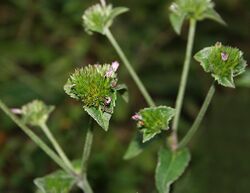Biology:Elephantopus scaber
| Elephantopus scaber | |
|---|---|

| |
| Elephantopus scaber in India | |
| Scientific classification | |
| Kingdom: | Plantae |
| Clade: | Tracheophytes |
| Clade: | Angiosperms |
| Clade: | Eudicots |
| Clade: | Asterids |
| Order: | Asterales |
| Family: | Asteraceae |
| Genus: | Elephantopus |
| Species: | E. scaber
|
| Binomial name | |
| Elephantopus scaber | |
| Synonyms[1] | |
| |
Elephantopus scaber is a tropical species of flowering plant in the family Asteraceae. It is native to tropical Africa, Eastern Asia, Indian Subcontinent, Southeast Asia, and northern Australia . It has become naturalized in tropical Africa and Latin America. Its natural habitat is subtropical or tropical moist montane forests.[2][3][4][5][6][7][8]
Uses
Elephantopus scaber is used as a traditional medicine.[9] Different parts of the plant are used in traditional medicine of India as an astringent agent, cardiac tonic, and diuretic, and is used for eczema, rheumatism, fever, and bladder stones.[10] E. scaber modulates inflammatory responses by inhibiting the production of TNFα and IL-1β.[11]
Chemical constituents
Elephantopus scaber contains elephantopin which is a germacranolide sesquiterpene lactone containing two lactone rings and an epoxide functional group.[12][13] 17,19-Dihydrodeoxyelephantopin, iso-17,19- dihydro-deoxy elephantopin and 8-hydroxyl naringenin are the most important bioactive compounds responsible for anti-bacterial activity.[citation needed] By UPLC MS Q-TOF, 34 components were identified.[11]
Subspecies and varieties
Varieties of E. scaber include:[1]
- Elephantopus scaber subsp. plurisetus (O.Hoffm.) Philipson
- Elephantopus scaber subsp. scaber
- Elephantopus scaber var. scaber
- Elephantopus scaber var. sinuatus (Mor.) Miq.
References
- ↑ 1.0 1.1 The Plant List, Elephantopus scaber L.
- ↑ Flora of China, 地胆草 di dan cao Elephantopus scaber Linnaeus, Sp. Pl. 2: 814. 1753.
- ↑ "Atlas of Living Australia, Elephantopus scaber L.". http://bie.ala.org.au/species/urn:lsid:biodiversity.org.au:apni.taxon:630174.
- ↑ Breedlove, D.E. 1986. Flora de Chiapas. Listados Florísticos de México 4: i–v, 1–246.
- ↑ Humbert, H. 1960. Composées. Fl. Madagasc. 189: 198-199 description in French
- ↑ Humbert, H. 1960. Composées. Fl. Madagasc. 189: plate I (1), figures 10-12 at right line drawings of Elephantopus scaber
- ↑ Jeffrey, C. 1988. Notes on Compositae: V. The Vernonieae in East Tropical Africa. Kew Bulletin 43(2): 195–277.
- ↑ Nelson, C. H. 2008. Catálogo de las Plantas Vasculares de Honduras 1–1576. Secretaria de Recursos Naturales y Ambiente, Tegucigalpa.
- ↑ Poli, A; Nicolau, M; Simoes, Cm; Nicolau, Rm; Zanin, M (Aug 1992). "Preliminary pharmacologic evaluation of crude whole plant extracts of Elephantopus scaber. Part I: in vivo studies". Journal of Ethnopharmacology 37 (1): 71–6. doi:10.1016/0378-8741(92)90005-C. ISSN 0378-8741. PMID 1453704.
- ↑ Wang, Limei; Waltenberger, Birgit; Pferschy-Wenzig, Eva-Maria; Blunder, Martina; Liu, Xin; Malainer, Clemens; Blazevic, Tina; Schwaiger, Stefan et al. (2014). "Natural product agonists of peroxisome proliferator-activated receptor gamma (PPARγ): A review". Biochemical Pharmacology 92 (1): 73–89. doi:10.1016/j.bcp.2014.07.018. PMID 25083916.
- ↑ 11.0 11.1 Abhimannue, Anu P.; Mohan, Mohind C.; B, Prakash Kumar (13 February 2016). "Inhibition of Tumor Necrosis Factor-α and Interleukin-1β Production in Lipopolysaccharide-Stimulated Monocytes by Methanolic Extract of Elephantopus scaber Linn and Identification of Bioactive Components". Applied Biochemistry and Biotechnology 179 (3): 427–443. doi:10.1007/s12010-016-2004-0. PMID 26875087.
- ↑ "Antitumor activity of elephantopus scaber linn against dalton's ascitis lymphoma". Indian Journal of Pharmaceutical Sciences 64 (1): 71–3. Jan–Feb 2002. http://medind.nic.in/imvw/imvw282.html.
- ↑ {{citation | mode = cs1 | title = Elephantopus scaber | work = Germplasm Resources Information Network (GRIN) | url = | publisher = [[Organization:Agricultural Research ServAgricultural Research Service (ARS), United States Department of Agriculture (USDA) | access-date = 7 May 2011 }}
Wikidata ☰ Q1039719 entry
 |

